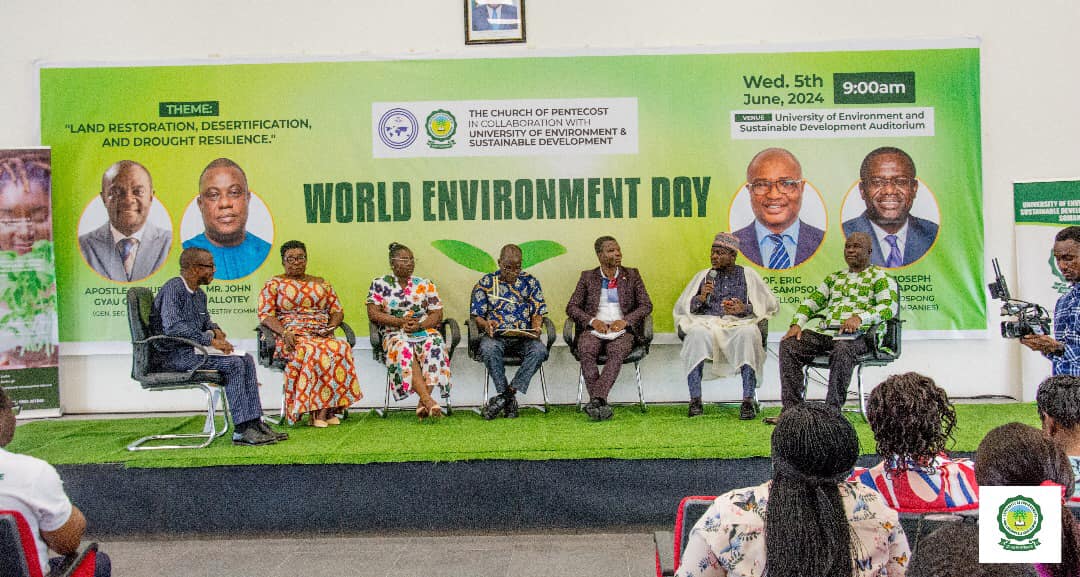By: University of Environment and Sustainable Development (UESD) in collaboration with the Church of Pentecost.
One of the highlights of the commemoration of this year’s World Environment Day was a panel discussion on the theme which featured representatives of NGOs, religious leaders, and academia.
Executive Summary
Land degradation, desertification, and increasing drought incidences pose significant threats to global ecosystems, economies, and communities. As discussed in the recent panel dialogue commemorating World Environment Day 2024, this policy brief outlines critical strategies and recommendations for addressing these intertwined challenges. Effective land restoration, combatting desertification, and enhancing drought resilience are essential to achieving sustainable development and climate resilience.
Key Issues
- Land Degradation: Over one-third of the world’s land is degraded due to deforestation, unsustainable agricultural practices, and urbanization, leading to diminished agricultural productivity, loss of biodiversity, and increased carbon emissions.
- Desertification: Affecting over 1 billion people globally, desertification results from land degradation in arid, semi-arid, and dry sub-humid areas. It exacerbates food and water insecurity, poverty, and migration.
- Drought Resilience: The increasing frequency and severity of droughts, driven by climate change, threaten water supplies, agricultural productivity, and ecosystem health. Building resilience requires proactive measures to manage and mitigate drought impacts.
Panel Discussion Insights
During the panel discussions, experts highlighted several key strategies and insights:
- Integrated Land Management: Implementing integrated approaches that combine sustainable agricultural practices, afforestation, and soil conservation techniques to restore degraded lands.
- Community Engagement: Empowering local communities and integrating indigenous knowledge in land restoration and drought resilience efforts to ensure sustainability and effectiveness.
- Innovative Technologies: Leveraging advancements in technology, such as remote sensing and Geographical Information Systems for monitoring land health, sustainable agriculture, and drought-resistant crop varieties to enhance resilience and restoration efforts.
- Policy and Governance: Establishing robust policy frameworks and governance structures that support land restoration initiatives, enforce sustainable land use practices, and provide incentives for restoration activities.
Policy Recommendations
- Strengthen Policy Frameworks:
- Develop and enforce national policies that prioritize land restoration and sustainable land management.
- Integrate land restoration goals into national development plans and climate adaptation strategies.
- Enhance Community Participation:
- Promote the inclusion of local communities and indigenous peoples in decision-making processes related to land management.
- Support community-led restoration projects through capacity building, technical assistance, and financial incentives.
- Invest in Research and Innovation:
- Fund research on drought-resistant crops, sustainable agricultural practices, and innovative water management techniques.
- Encourage the development and dissemination of technologies that support monitoring and restoration efforts, such as satellite imagery and GIS mapping.
- Increase Financial Support:
- Mobilize financial resources from public and private sectors to fund large-scale land restoration projects.
- Create financial incentives for farmers and landowners to adopt sustainable practices, such as subsidies, tax breaks, and grants.
- Foster International Cooperation:
- Strengthen international collaborations to share knowledge, technologies, and best practices for land restoration and drought resilience.
- Support global initiatives like the United Nations Convention to Combat Desertification (UNCCD) and the Great Green Wall initiative in Africa.
- Implement Sustainable Agricultural Practices:
- Encourage the adoption of agroforestry, conservation agriculture, and other sustainable farming practices that improve soil health and water retention.
- Promote crop diversification and the use of cover crops to enhance resilience to drought and prevent soil erosion.
- Improve Water Management:
- Invest in infrastructure for efficient water use, such as rainwater harvesting systems, drip irrigation, and water recycling.
- Develop and implement water management plans that prioritize the sustainable use of water resources and mitigate the impacts of drought.
- Raise Awareness and Education:
- Conduct public awareness campaigns to highlight the importance of land restoration and sustainable land management.
- Integrate environmental education into school curricula to build a culture of sustainability and stewardship from a young age.
Conclusion
A coordinated and multifaceted approach is necessary to address the complex and interconnected challenges of land degradation, desertification, and drought resilience. These policy recommendations can be implemented to improve our efforts to restore degraded lands, combat desertification, and develop drought resilience. This will not only enhance environmental health but also enhance the overall well-being of communities worldwide, as well as contribute to economic stability, agricultural security, and environmental health.

